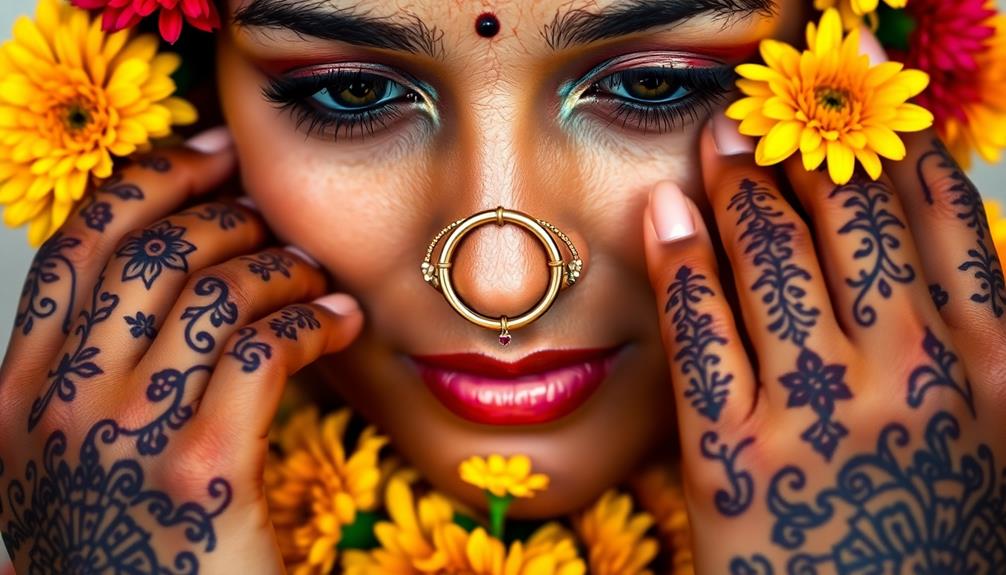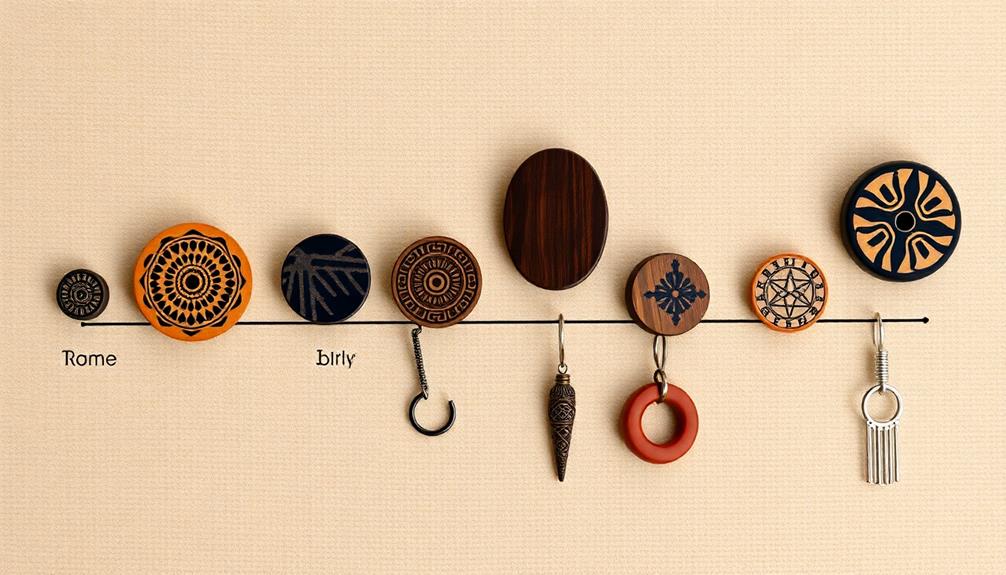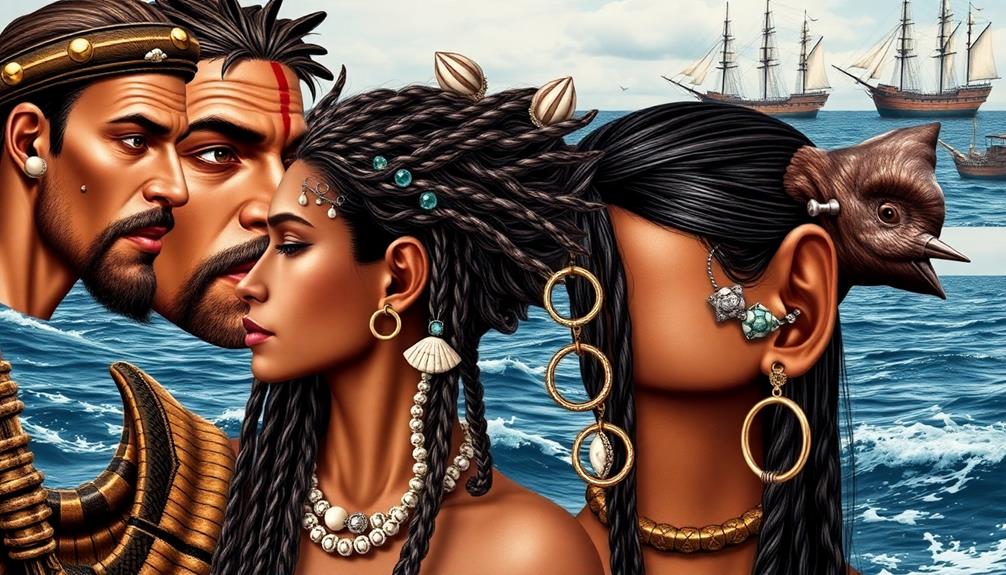Nose piercings in Indian culture carry deep significance beyond mere decoration. They symbolize important life stages like marriage and fertility, often linked to goddess Parvati, reflecting rich traditions. You'll notice varied preferences across regions; Northern women typically favor left nostril piercings, while Southern traditions might choose the right. Different styles, like the ornate Maharashtrian nath, showcase individual and cultural identity. Today, nose piercings also blend with contemporary fashion, empowering personal expression. This connection echoes a transformative journey through culture and modernity, revealing intricate stories that connect tradition with identity. Discover more about this fascinating cultural expression ahead.
Key Takeaways
- Nose piercings date back over 4,000 years, symbolizing wealth and status, particularly in Middle Eastern and Indian cultures.
- In India, left nostril piercings are traditionally linked to fertility and marital status, while right nostril piercings are favored in the South.
- Nose jewelry styles, such as Nath and Phul Nath, showcase intricate artistry and cultural significance, connecting women to their heritage.
- Nose piercings serve as symbols of empowerment, allowing women to express individuality while honoring cultural traditions and societal beliefs.
- Contemporary trends blend traditional aesthetics with modern fashion, reflecting the evolving significance of nose piercings in Indian identity.
Historical Roots of Nose Piercings

Nose piercing has deep historical roots that stretch back over 4,000 years, making it a fascinating aspect of cultural heritage. Originally, it emerged in the Middle East as a Shanf, symbolizing wealth as noted in the Bible.
When Mughal invaders arrived in India during the 16th century, they introduced the practice of nose piercings, influenced by the prevalent Persian and Arabic cultures that embraced nose rings.
In Indian culture, nose piercings quickly became more than just a fashion statement. Ancient Ayurvedic texts, including the Sushruta Samhita, highlighted the left nostril piercing for its supposed medicinal benefits, particularly in alleviating menstrual pain.
This ancient medicinal perspective not only showcases the practical roots of nose piercings but also intertwines them with spiritual and cultural significance.
In Hinduism, nose piercings symbolize marriage and fertility, closely associated with the goddess Parvati, reflecting the importance of these piercings in various life stages.
The rich history of nose piercings reveals their deep-seated significance in Indian culture, marking them as a vibrant expression of identity and tradition that has evolved over centuries.
Cultural Variations in India
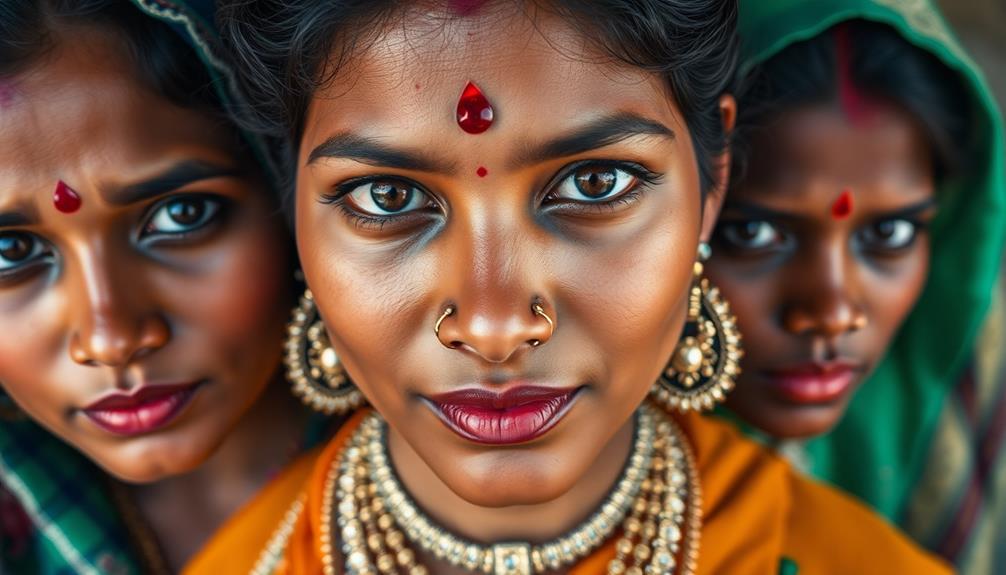
Frequently, cultural variations in nose piercings across India highlight the rich diversity of traditions and practices within the country. In many northern, western, and central regions, you'll notice that Indian women mainly opt for a nose piercing in the left nostril. This choice often symbolizes fertility and marital status, especially within Hindu culture.
Conversely, in South Indian traditions, the right nostril is typically favored for piercings, showcasing a distinct regional preference.
You might also observe that some areas embrace dual nostril piercings or even septum piercings, further reflecting the varied practices throughout India. The designs of these piercings can differ greatly, with the ornate Maharashtrian nath standing out as a larger statement piece, while southern styles tend to be simpler and more understated.
Notable figures like MS Subbulakshmi exemplify how these cultural variations not only honor tradition but also allow for personal expression. Through their choices in nose piercings, Indian women celebrate their heritage, showcasing the intricate tapestry of cultural significance that nose piercings hold across this vibrant nation.
Types of Nose Pins
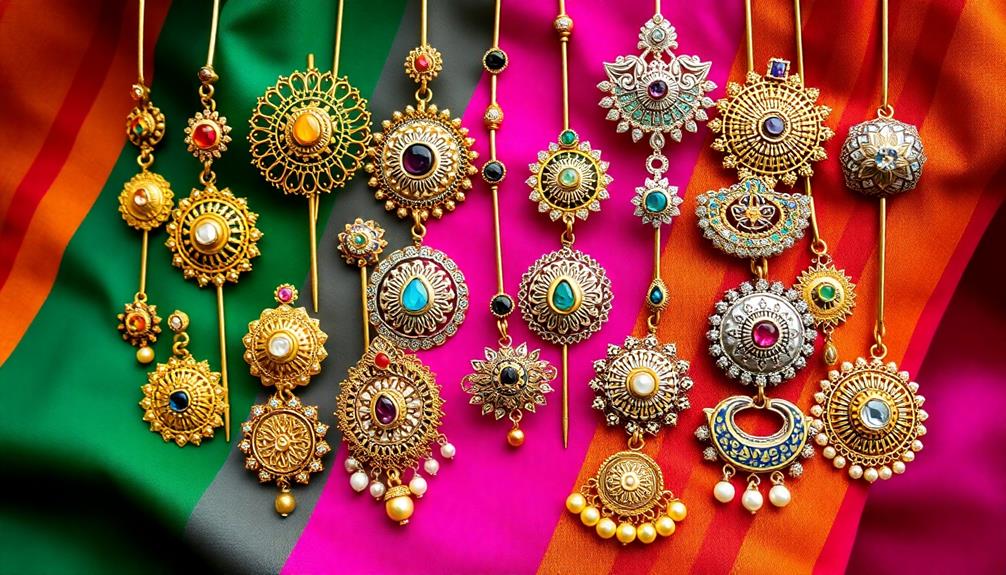
When exploring the world of Indian nose pins, you'll find a stunning array of styles that reflect the country's rich cultural heritage. Each design serves not just as an accessory but also as a symbol of identity among Indian women.
Here are three notable types of nose pins:
- Maharashtrian Nath: This larger, ornate nose pin is often embellished with precious stones and is essential to traditional Maharashtrian attire, enhancing the beauty of bridal looks.
- Phul Nath: Known for its vibrant flower-shaped design, the Phul Nath is frequently worn during weddings and celebrations. Its aesthetic appeal resonates with the cultural significance of joyous occasions.
- Laung Nath: This nose pin, shaped like a clove and featuring intricate carvings, is especially popular in North India. It's a reflection of regional jewelry preferences, showcasing the diversity of Indian styles.
The diversity in nose pin designs, including gold nose pins, underscores their importance in Indian culture, connecting women to their heritage and traditions.
Traditional Jewelry Styles

When it comes to traditional nose jewelry styles, you'll find a rich variety that reflects cultural heritage and personal significance.
Classic designs like the Nath and Phul Nath showcase intricate artistry, while contemporary trends keep evolving, blending modern elements with timeless beauty.
Let's explore how these classic and modern styles come together in today's jewelry landscape.
Classic Nose Pin Designs
Classic nose pin designs in Indian culture showcase a rich tapestry of artistry and tradition.
These pieces of elaborate nose jewelry not only enhance beauty but also carry deep cultural significance. You might find yourself drawn to various classic Indian nose pin designs, each reflecting unique regional styles and meanings.
- Nathni: A small gold nose pin connected to the ear by a chain, symbolizing bridal status and often worn during significant life events.
- Maharashtrian Nath: This larger, ornate nose pin is adorned with precious stones, making it a staple during weddings and festivals.
- Phul Nath: Popular among Bengali women, this vibrant flower-shaped design is typically worn during auspicious occasions, adding a festive touch to traditional attire.
These designs are more than just accessories; they represent a woman's identity and heritage.
The Laung Nath, resembling a clove, and the Mukhuttis, a pair of studs for both nostrils, further illustrate the diversity in styles across different Indian communities.
Each piece you choose can connect you to a rich cultural legacy.
Contemporary Jewelry Trends
Contemporary jewelry trends are redefining traditional nose jewelry styles, blending age-old craftsmanship with modern aesthetics. You'll notice how classic designs, like the Nath, are evolving. In Northern India, larger, ornate pieces remain popular, while simpler styles from the South are also making a comeback. This fusion allows you to appreciate both heritage and current fashion.
Brands are offering a variety of nose pins that reflect this blend, showcasing traditional craftsmanship alongside contemporary influences. Special occasion pieces, featuring elaborate gem-decorated hoops and intricate designs like mookuthi, highlight the significance of nose jewelry during cultural events like weddings.
Since 2015, the resurgence of septum piercings has increased interest in nose jewelry, particularly among younger generations. You'll find both traditional and modern designs showcased on social media and fashion runways, making it easier than ever to express your individual style.
These contemporary jewelry trends not only celebrate India's rich history but also invite you to experiment with your look, combining tradition with the latest fashion statements. Embrace this evolution, and let your nose jewelry reflect your unique identity.
Modern Fashion Trends
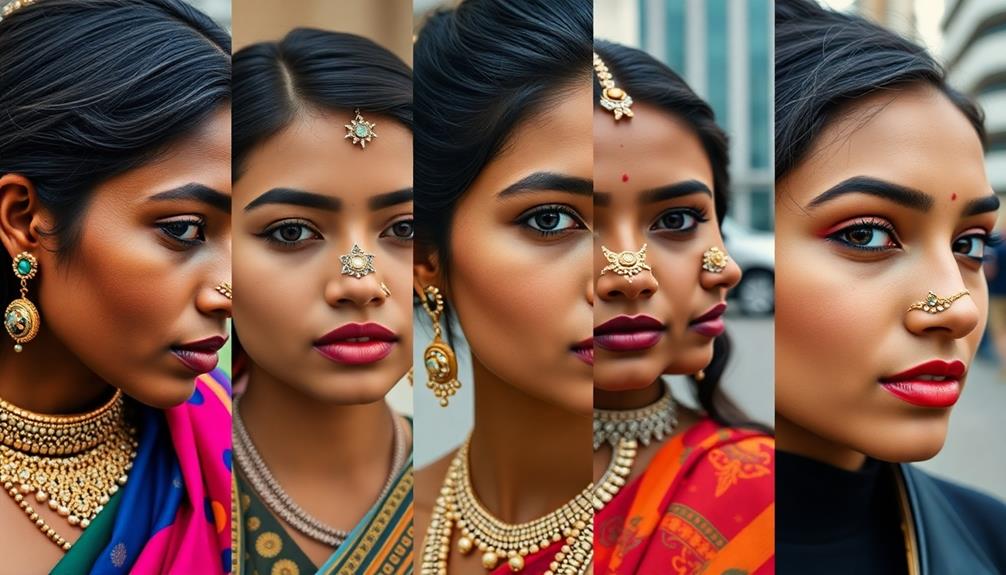
Nose piercings have become a must-have accessory in modern fashion, seamlessly blending traditional Indian aesthetics with contemporary style. Since 2015, the resurgence of nose piercings, especially septum styles, has been fueled by high-profile runway shows and the influence of celebrities.
Social media platforms have played a pivotal role in popularizing nose pins, making them a trendy choice for the younger generation.
Here are three key trends in contemporary Indian fashion regarding nose piercings:
- Mix and Match: People often pair nose pins with western outfits like maxi dresses and crop tops, creating a unique fusion of cultures.
- Celebrity Influence: Fashion icons and influencers showcase various nose pin styles, encouraging fans to embrace both traditional and modern designs.
- Modern Jewelry Brands: A surge of brands offers a diverse range of nose pin designs, utilizing precious materials like diamonds and metals, catering to various occasions.
With these trends, nose piercings not only enhance your style but also celebrate the rich cultural heritage of India, making them more than just a fashion statement.
Symbolism and Significance
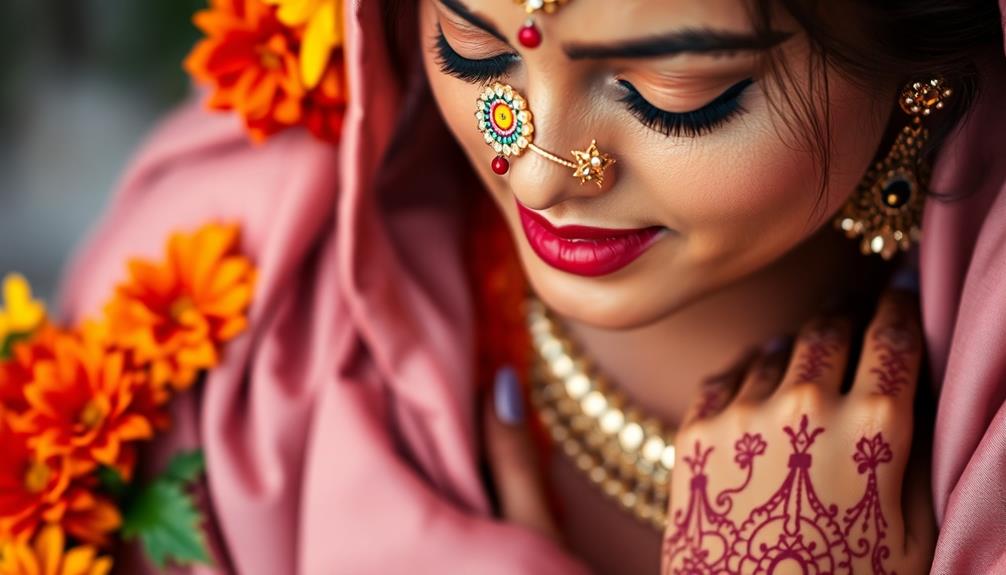
In Indian culture, the symbolism of nose piercings goes far beyond mere decoration; they represent deep-rooted traditions and societal beliefs. For many Indian women, wearing nose rings is a significant rite of passage, often associated with marriage and fertility.
In Hindu communities, the left nostril is particularly revered, believed to enhance reproductive health. This connection is why the nath, a type of nose pin, often symbolizes a woman's marital status, prominently displayed during weddings and festivals.
Historically, texts like the Sushruta Samhita emphasize the medicinal benefits of nose piercings, suggesting they can alleviate menstrual discomfort, further embedding these practices into societal norms.
The variations in nose piercing customs across regions—like the preference for the left nostril in the North versus the right in the South—reflect local identities and beliefs.
Ultimately, the symbolism behind nose rings transcends mere aesthetics; it embodies beauty, femininity, and social status. As you explore the significance of these adornments, you'll discover how they serve as expressions of cultural heritage, evolving over time while retaining their profound meanings.
Feminism and Personal Expression

Nose piercings can empower you to embrace your cultural identity while expressing your individuality.
Many women see these adornments as a way to challenge traditional norms, turning a symbol of tradition into a personal statement.
As you explore the intersection of feminism and personal expression, consider how these choices reflect both heritage and modernity.
Empowerment Through Tradition
Piercings symbolize a rich tapestry of cultural significance, especially in Indian society where they embody empowerment and personal expression. The act of adorning your nostril with an Indian nose ring isn't just about beauty; it represents a connection to deep-rooted traditions and beliefs about women's roles.
This practice often marks a rite of passage, empowering young women and indicating their readiness for marriage.
Here are three ways nose piercings foster empowerment through tradition:
- Cultural Identity: A gold nose ring links you to your heritage, celebrating your roots and the rich history of your ancestors.
- Expression of Individuality: In modern contexts, the nose piercing serves as a rebellious statement, allowing you to assert your personal choices and defy traditional norms.
- Celebration of Femininity: Wearing a nose ring connects you to the goddess Parvati, symbolizing fertility and strength, reinforcing the idea that femininity can be both powerful and beautiful.
In this blend of tradition and modernity, nose piercings empower you to embrace your cultural identity while expressing yourself uniquely.
Individuality and Cultural Identity
Embracing a nose piercing allows you to express your individuality while honoring cultural identity. In Indian culture, nose piercings symbolize a unique blend of personal expression and adherence to traditional practices. For many young women, this act serves as a rite of passage, marking their evolution into adulthood and independence.
Today, these piercings are increasingly seen as a feminist statement, showcasing autonomy and defying societal norms regarding women's appearances. When you choose to adorn your nose, you're not just making a fashion choice—you're asserting your right to define your identity on your terms.
Personal motivations for getting a nose piercing often reflect a desire to connect with cultural heritage while embracing modernity. Many women skillfully integrate traditional designs into their contemporary fashion, creating a unique style that honors their roots.
As the popularity of nose piercings grows among the South Asian diaspora, it becomes an act of resistance against cultural assimilation. You reclaim your heritage, celebrating your individuality and cultural identity through this powerful form of self-expression.
In doing so, you create a space where tradition and modernity coexist beautifully.
Related Cultural Practices

In Indian culture, the practice of nose piercing is just one facet of a rich tapestry of related cultural expressions. For Hindu women, nose piercings symbolize not only beauty but also marriage and fertility. According to Ayurvedic texts, the left nostril is believed to enhance reproductive health, making this tradition particularly significant.
Here are three related cultural practices that complement nose piercings:
- Rite of Passage: Many communities perform the piercing around the age of 16, signaling a young woman's readiness for marriage, reinforcing her role within the family and society.
- Traditional Nose Jewelry: Festivals and weddings prominently feature traditional nose jewelry, like nath or mukhutti. These adornments are considered essential to bridal attire, enhancing the overall aesthetic on special occasions.
- Wearing Bindis: In addition to nose piercings, wearing bindis symbolizes feminine energy and marital status. This practice highlights the interconnectedness of body art and traditional attire, creating a cohesive cultural identity.
These practices reflect the diverse customs across regions, showcasing how nose piercings integrate into broader cultural narratives in India.
Frequently Asked Questions
Why Is Nose Piercing Important in India?
Nose piercing's important because it symbolizes beauty and femininity in various cultures. It connects you to traditions, enhances your style, and reflects personal identity. Understanding its significance can deepen your appreciation for this art form.
What Does Hinduism Say About Nose Piercing?
Hinduism links nose piercing to women's health and marital readiness. It's said to enhance reproductive well-being and alleviate menstrual pain, reflecting deeper spiritual beliefs about femininity, identity, and societal roles within the faith.
What Does the Left Side Nose Piercing Mean in India?
Left side nose piercings signify femininity and fertility. They celebrate your transformation into womanhood, marking cultural identity and marital status. Wearing traditional jewelry enhances your beauty while connecting you to ancient beliefs about well-being.
What Is the Cultural Significance of Nose Piercings?
Nose piercings carry deep cultural significance, representing identity and tradition. They often mark important life events and symbolize beauty, femininity, or marital status, connecting you to heritage while allowing personal expression in contemporary fashion.
Conclusion
To sum up, nose piercings in Indian culture reflect a rich tapestry of history, symbolism, and evolving fashion. As the saying goes, "Beauty is in the eye of the beholder," and this tradition highlights personal expression and individuality. Whether you're drawn to the traditional styles or modern trends, embracing this art form can connect you to a deeper cultural narrative. Ultimately, nose piercings serve as a celebration of identity, bridging generations and styles in a vibrant way.
Hi, my name is Danielle, and I’m an author for piercings-body.com. I have a passion for writing and love to share my knowledge on all things body piercing-related. I’m also a huge advocate for safe body modification practices and believe everyone should be able to make informed decisions about their bodies. When I’m not writing or blogging, I enjoy spending time with my family and friends, practicing yoga, and exploring new places.

